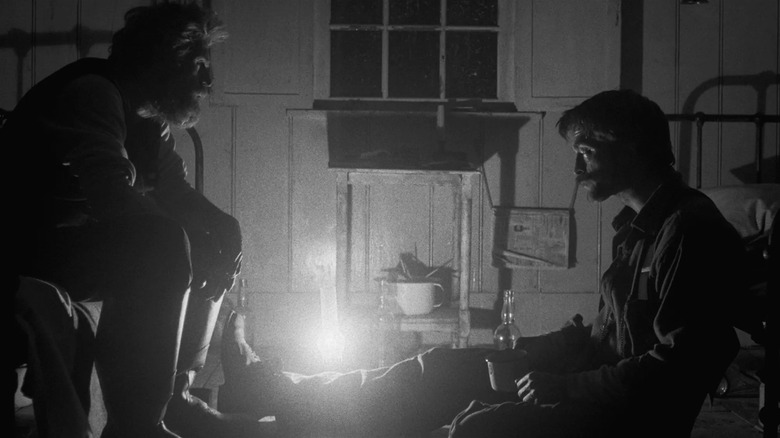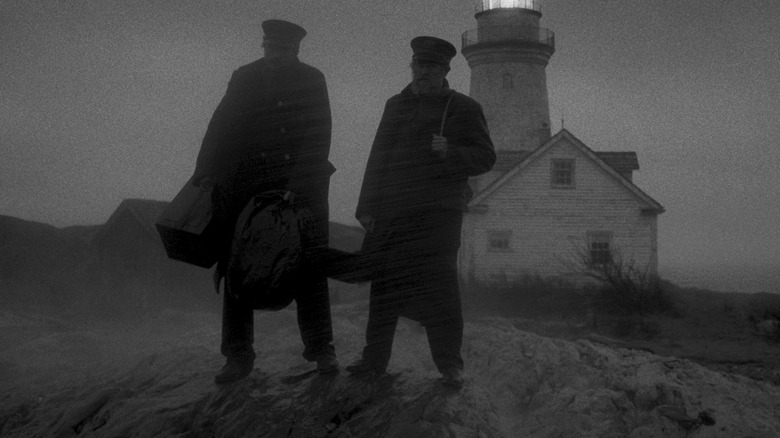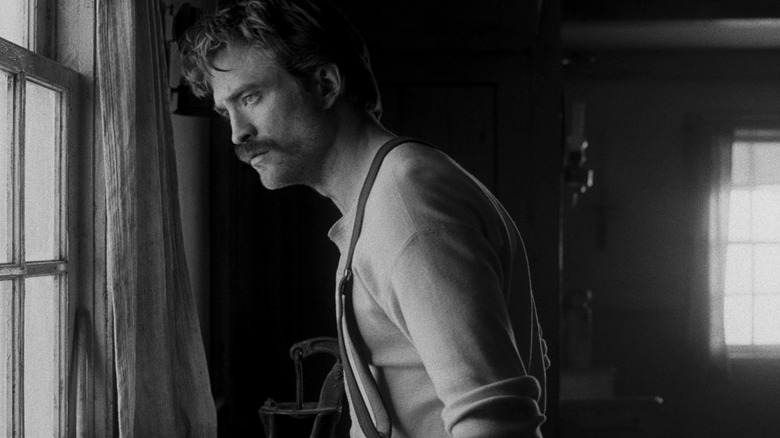Robert Eggers' The Lighthouse Comes From A Terrifying True Story
Can complete and utter isolation shatter one's concept of the self and their sense of reality? The answers might vary, but in Robert Eggers' "The Lighthouse," an isolation-induced psychological breakdown is a shared experience that festers and mutates between two men forced to share a cramped lighthouse quarter off the coast of New England. Lighthouse keepers Thomas Wake (Willem Dafoe) and Ephraim (Robert Pattinson) might appear to share conflicting sensibilities, but their tense, volatile relationship accommodates multitudes. There's incessant bickering and incandescent rage, unflinchingly honest heart to hearts, and tender, drunken camaraderie that often edges towards repressed homoeroticism.
As a result, isolation is the most benign threat in "The Lighthouse" — if anything, the presence of the other intensifies the feeling of being trapped in a horrifying fever dream, where intense, infectious chaos ricochets between two souls until it devours the very fabric of their realities. The irony of two lighthouse keepers, who are traditionally meant to act as north stars for lost ships at sea and provide solace to sailors during tough tides, breaking away from reality is not lost here, cementing the trope of the overreacher and the price that must be paid for such transgressions.
While Eggers' exploration of isolation and mirrored frenzy (among other things) in "The Lighthouse" is a reflection of his directorial sensibilities, this story is a dramatization of a true-life tale that continues to terrify and fascinate. The story of the Smalls Lighthouse might not feature howling mermaids or hostile seagulls, but it centers around two men sharing a lighthouse quarter, and the tragic circumstances that befell the duo stranded on Pembrokeshire's battered rocks. While Eggers was not the first one to dramatize the Smalls Lighthouse incident, his re-interpretation of the tale is certainly the most complex and heady, entrenched in varied, interpretative symbolism.
A terrible tragedy
The Smalls incident occurred in 1801, a time during which two-man lighthouse-keeping teams were pretty much the standard. Thomas Howell and Thomas Griffith, who were publicly known to have gotten into arguments prior to being stationed together, had to put their differences aside and work as a team for the sake of their jobs. As the two famously did not get along, one can only assume how tense this shared space must have been, isolation being the only option amid horrid storms. However, real tragedy struck when Griffith fell ill due to the extreme weather and died soon after, despite Howell's attempts to send distress signals and apply first aid to the best of his abilities.
While Griffith's sudden death is jarring enough, things took a morbid turn when Howell decided to not dispose of the body out of fear that he might be accused of murder, as their mutual dislike was public knowledge. He let Griffith's corpse remain inside the cramped quarters as he went about his duties for days and only decided to craft a makeshift coffin after the body had started to decompose. Howell dragged the coffin outside and haphazardly propped it against the rickety building, but after days of extreme weather, the coffin gave away, until the corpse's detached hand could be seen swaying in the wind from inside the hut. The trauma of isolation, coupled with the sight of the severed hand, drove Howell to the brink of a mental collapse.
After Howell was rescued, he reintegrated into society a broken, hollow man who seemed unrecognizable to even those closest to him. The public knowledge of the incident essentially changed how lighthouse keeper teams were stationed, as a new policy stated that groups would at least constitute three men, and never two.
How The Lighthouse hones in on shared paranoia
The Howell-Griffith story is undoubtedly a tragic one, and this real-life incident forced everyone in the profession to consider the perils of isolation seriously and ponder the limits of human endurance when faced with harsh natural conditions and the unknown. The unknown here is the unpredictable toll of trauma on the human mind, but "The Lighthouse" takes these horrors even further by infusing them with literary allusions and psychological layers that can be interpreted and dissected via various lenses. To question whether what unravels is "real" or not is beside the point, as the film is meant to be a portal to an event that oscillates between realistic and mythical, touching upon fear, desire, hubris, and existential doubts within a context that pushes two people to extremes.
Whether you wish to interpret the film as a Promethean allegory or a visceral exploration of human relationships comes down to personal leanings, but the isolation aspect of "The Lighthouse" is ever-present, despite not being the sole focus of the film. The idea of being stranded on a piece of rock, with few tools to brave the wrath of nature or the cruelties of fellow man already etches a horrifying picture of fear, exposing one to sights that both madden and illuminate.
In the end, Ephraim's knowledge of what's forbidden comes at a tremendous cost — the nature of this truth is up to interpretation, as it can be something as profound as a life-altering epiphany or as mind-breaking as the existence of eldritch terrors. Even after the truth floods through, humanity finds itself intensely alone, left to rot on the beach while being pecked by a horde of seagulls.


